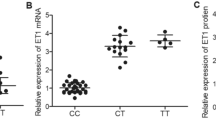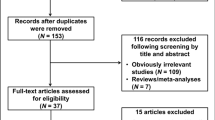Abstract
Aneurysmal subarachnoid hemorrhage (aSAH) occurs more often in postmenopausal women than in men. Estrogen plays an important role in vascular homeostasis. Our aim was to elucidate whether a drop in circulating estradiol in conjunction with variants of estrogen receptor genes have a role in female gender susceptibility to aSAH. A total of 709 subjects were enrolled (349 aSAH patients, 360 controls) and genotyped for rs2234693 or PvuII (intron 1, T>C) in the ESR1 gene and rs4986938 or AluI (exon 8, 1730G>A) of ESR2 gene by PCR-RFLP. Serum estradiol was estimated by ELISA. Estrogen receptor gene expression was studied by qRT-PCR. Logistic regression analysis indicated a significant recessive effect of the T allele of PvuII on aSAH in females, and this association remained statistically significant even after adjusting for confounders (OR 1.702, CI 95% 1.062, 2.726, P value = 0.027). ESR1 gene expression was significantly reduced (P value = 0.0089) in subjects carrying PvuII T allele. In postmenopausal women with TT genotype and low serum estradiol, the odds for developing aSAH were found to be 3.5-fold increase compared with premenopausal women (CI 95% 1.424–8.828, P value = 0.0074). However, this variant showed no significant association with aSAH in men. No significant difference was found in genotype and allelic distribution of AluI polymorphism in ESR2 gene, between patients and controls. We propose that the PvuII T allele could be a potential pharmacogenetic marker for strategizing personal medicine for preventing aSAH in postmenopausal women with low circulating estradiol. Further larger studies in other population are warranted.
This is a preview of subscription content, access via your institution
Access options
Subscribe to this journal
Receive 6 print issues and online access
$259.00 per year
only $43.17 per issue
Buy this article
- Purchase on Springer Link
- Instant access to full article PDF
Prices may be subject to local taxes which are calculated during checkout


Similar content being viewed by others
References
de Rooij NK, Linn FH, van der Plas JA, Algra A, Rinkel GJ. Incidence of subarachnoid haemorrhage: a systematic review with emphasis on region, age, gender and time trends. J Neurol Neurosurg Psychiatry. 2007;78:1365–72.
Herrington DM, Howard TD, Hawkins GA, Reboussin DM, Xu J, Zheng SL, et al. Estrogen-receptor polymorphisms and effects of estrogen replacement on high-density lipoprotein cholesterol in women with coronary disease. N Engl J Med. 2002;346:967–74.
Turan N, Heider RA, Zaharieva D, Ahmad FU, Barrow DL, Pradilla G. Sex differences in the formation of intracranial aneurysms and incidence and outcome of subarachnoid hemorrhage: review of experimental and human studies. Transl Stroke Res. 2016;7:12–9.
Mariah RA, Baghdadi H, Ahmed KE, Mostafa N, Ayat Ahemd MM, Nansour T. et al. Frequency of estrogen receptor-1 (ESR-1) gene polymorphism (PvuII and XbaI) in patients with coronary artery disease. Am J Med Biol Res. 2016;4:5–9.
Prossnitz ER, Arterburn JB. International Union of Basic and Clinical Pharmacology. XCVII. G protein-coupled estrogen receptor and its pharmacologic modulators. Pharmacol Rev. 2015;67:505–40.
Ramesh SS, Christopher R, Indira Devi B, Bhat DI. The vascular protective role of oestradiol: a focus on postmenopausal oestradiol deficiency and aneurysmal subarachnoid haemorrhage. Biol Rev Camb Philos Soc. 2019. https://doi.org/10.1111/brv.12541.
Stirone C, Duckles SP, Krause DN. Multiple forms of estrogen receptor-alpha in cerebral blood vessels: regulation by estrogen. Am J Physiol Endocrinol Metab. 2003;284:E184–92.
Strand M, Söderström I, Wiklund PG, Hallmans G, Weinehall L, Söderberg S, et al. Estrogen receptor alpha gene polymorphisms and first-ever intracerebral hemorrhage. Cerebrovasc Dis. 2007;24:500–8.
Rebaï M, Rebaï A. In silico characterization of functional SNP within the oestrogen receptor gene. J Genet. 2016;95:865–74.
Markoula S, Milionis H, Lazaros L, Spengos K, Vassilopoulou S, Chatzistefanidis D, et al. Associations of ESR2 AluI (G/A) polymorphism with ischemic stroke in Caucasians. J Neurol Sci. 2012;316:126–30.
Markoula S, Xita N, Lazaros L, Giannopoulos S, Kyritsis AP, Georgiou I. Estrogen receptor alpha gene haplotypes and diplotypes in the risk of stroke. Stroke. 2008;39:e172–3.
Report of World Federation of Neurological Surgeons Committee on a Universal Subarachnoid Hemorrhage Grading Scale. J Neurosurg 1988;68:985–6.
Fisher CM, Kistler JP, Davis JM. Relation of cerebral vasospasm to subarachnoid hemorrhage visualized by computerized tomographic scanning. Neurosurgery. 1980;6:1–9.
Ghatak S, Muthukumaran RB, Nachimuthu SK. A simple method of genomic DNA extraction from human samples for PCR-RFLP analysis. J Biomol Tech. 2013;24:224–31.
Turner S, Armstrong LL, Bradford Y, Carlson CS, Crawford DC, Crenshaw AT, et al. Quality control procedures for genome-wide association studies. Curr Protoc Hum Genet. 2011. https://doi.org/10.1002/0471142905.hg0119s68.
Kongable GL, Lanzino G, Germanson TP, Trukowski LL, Alves WM, Torner JC, et al. Gender-related differences in aneurysmal subarachnoid hemorrhage. J Neurosurg. 1996;84:43–8.
O’Lone R, Knorr K, Jaffe IZ, Schaffer ME, Martini PG, Karas RH, et al. Estrogen receptors α and ß mediate distinct pathways of vascular gene expression, including genes involved in mitochondrial electron transport and generation of reactive oxygen species. Mol Endocrinol. 2007;21:1281–96.
Herrington DM, Howard TD, Brosnihan KB, McDonnell DP, Li X, Hawkins GA, et al. Common estrogen receptor polymorphism augments effects of hormone replacement therapy on E-selectin but not C-reactive protein. Circulation. 2002;105:1879–82.
Putnik M, Zhao C, Gustafsson JA, Dahlman-Wright K. Effects of two common polymorphisms in the 3’ untranslated regions of estrogen receptor beta on mRNA stability and translatability. BMC Genet. 2009;10:55.
Lazaros L, Markoula S, Xita N, Giannopoulos S, Gogou P, Lagos G, et al. Association of estrogen receptor-alpha gene polymorphisms with stroke risk in patients with metabolic syndrome. Acta Neurol Scand. 2008;117:186–90.
Shearman AM. Oestrogen receptor genetics: a needle that cuts through many haystacks? Eur Heart J. 2006;27:1519–20.
Munshi A, Sharma V, Kaul S, Al Hazzani A, Alshatwi AA, Manohar VR, et al. Estrogen receptor α genetic variants and the risk of stroke in a South Indian population from Andhra Pradesh. Clin Chim Acta. 2010;411:1817–21.
Schuit SC, de Jong FH, Stolk L, Koek WN, van Meurs JB, Schoofs MW, et al. Estrogen receptor alpha gene polymorphisms are associated with estradiol levels in postmenopausal women. Eur J Endocrinol. 2005;153:327–34.
Chen M, Ouyang B, Goldstein-Smith L, Feldman L. Oral contraceptive and hormone replacement therapy in women with cerebral aneurysms. J NeuroInterv Surg. 2011;3:163–6.
Mhurchu CN, Anderson C, Jamrozik K, Hankey G, Dunbabin D. The hormonal factors and risk of aneurysmal subarachnoid hemorrhage: an international population-based, case–control study. Stroke. 2001;32:606–12.
Khalil RA. Estrogen, vascular estrogen receptor and hormone therapy inpostmenopausal vascular disease. Biochem Pharmacol. 2013;86:1627–42.
Ryan J, Canonico M, Carcaillon L, Carrière I, Scali J, Dartigues JF, et al. Hormone treatment, estrogen receptor polymorphisms and mortality: a prospective cohort study. PLoS ONE. 2012;7:e34112.
Marini H, Currò M, Adamo EB, Polito F, Ferlazzo N, Bitto A, et al. The ESR2 AluI 1730G>A (rs4986938) gene polymorphism is associated with fibrinogen plasma levels in postmenopausal women. Gene. 2012;508:206–10.
Domingues-Montanari S, Subirana I, Tomás M, Marrugat J, Sentí M. Association between ESR2 genetic variants and risk of myocardial infarction. Clin Chem. 2008;54:1183–9.
Acknowledgements
We thank the Indian Council of Medical Research (ICMR), New Delhi, India and the Department of Science and Technology (DST), New Delhi, India for the funding, and the Vision Group on Science and Technology (VGST), Karnataka, India for providing qRT-PCR equipment. We also thank all the volunteers who consented to participate in this study.
Author information
Authors and Affiliations
Corresponding author
Ethics declarations
Conflict of interest
The authors declare that they have no conflict of interest.
Additional information
Publisher’s note Springer Nature remains neutral with regard to jurisdictional claims in published maps and institutional affiliations.
Supplementary information
Rights and permissions
About this article
Cite this article
Ramesh, S.S., Christopher, R., Devi, B.I. et al. Estrogen receptor alpha gene variant, PvuII (rs2234693), as a potential pharmacogenetic biomarker for aneurysmal subarachnoid hemorrhage in postmenopausal women. Pharmacogenomics J 20, 655–663 (2020). https://doi.org/10.1038/s41397-020-0155-4
Received:
Revised:
Accepted:
Published:
Issue Date:
DOI: https://doi.org/10.1038/s41397-020-0155-4



